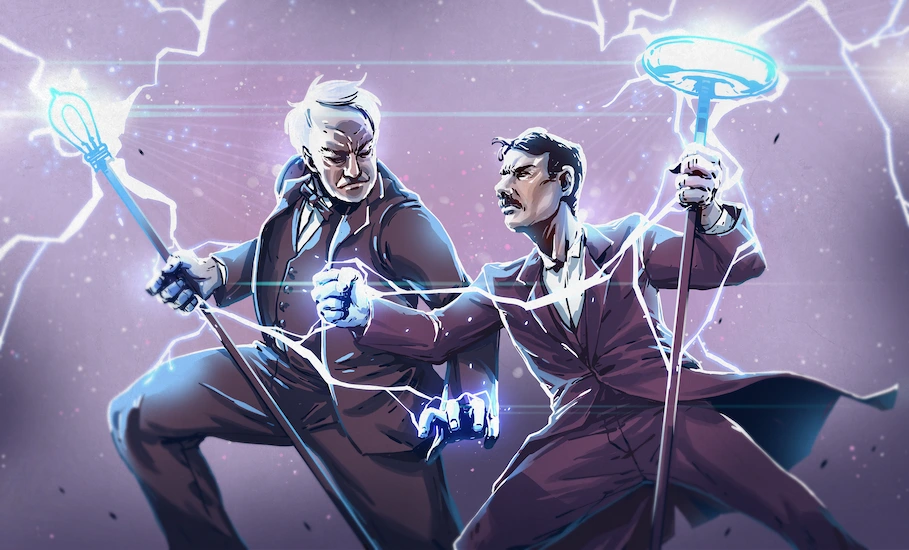Tesla vs. Edison: The Greatest Rivalry in Science
May 16, 2024
Science Biography

The rivalry between Nikola Tesla and Thomas Edison is one of the most famous and influential in the history of science and technology. Their competition, known as the "War of the Currents," not only shaped the development of electrical systems but also left a lasting impact on the world of innovation. This blog will delve into the lives and achievements of these two remarkable inventors, explore the nature of their rivalry, and examine the legacy they left behind.
The Early Lives of Tesla and Edison
Thomas Edison: The Inventive Prodigy
Thomas Alva Edison was born on February 11, 1847, in Milan, Ohio. Despite limited formal education, Edison's curiosity and inventive mind were evident from a young age. He began his career as a telegraph operator and soon started experimenting with electrical devices. By his early twenties, Edison had established himself as a prolific inventor with numerous patents to his name.
Edison is best known for his work on the phonograph, the incandescent light bulb, and the development of the first commercial electric power distribution system. His laboratory in Menlo Park, New Jersey, became a hub of innovation, where he and his team developed many groundbreaking technologies.
Nikola Tesla: The Visionary Engineer
Nikola Tesla was born on July 10, 1856, in Smiljan, in what is now Croatia. Unlike Edison, Tesla received a formal education in engineering and physics. He studied at the Austrian Polytechnic in Graz and later at the University of Prague. Tesla's fascination with electricity began during his student years, and he envisioned new ways to harness and distribute electrical power.
Tesla emigrated to the United States in 1884, arriving in New York with little more than a letter of introduction to Thomas Edison. Tesla's unique ideas and visionary approach would soon set him apart from his contemporaries.
The War of the Currents
Direct Current vs. Alternating Current
The core of the Tesla-Edison rivalry centered around two competing electrical systems: Edison's direct current (DC) and Tesla's alternating current (AC).
-
Direct Current (DC): Edison's DC system provided a steady flow of electricity in one direction. While effective for short distances, DC power had significant limitations, particularly in its inability to be easily transformed to different voltages, making it inefficient for long-distance transmission.
-
Alternating Current (AC): Tesla's AC system, on the other hand, allowed the flow of electricity to periodically reverse direction. AC could be easily transformed to different voltages using transformers, making it far more efficient for transmitting power over long distances.
The Clash Begins
Tesla initially worked for Edison but left due to differences in their approaches and philosophies. Edison focused on practical, incremental improvements, while Tesla pursued more theoretical and groundbreaking innovations.
Tesla found a new ally in George Westinghouse, an industrialist who recognized the potential of AC power. Westinghouse purchased Tesla's patents and began promoting AC as the future of electrical distribution.
The Public Battle
Edison, determined to protect his investment in DC, launched a public campaign to discredit AC power. He argued that AC was dangerous and unsuitable for household use. Edison even staged public demonstrations where animals were electrocuted using AC power to highlight its dangers, a tactic that led to the development of the electric chair as a means of capital punishment.
Despite Edison's efforts, the advantages of AC power became increasingly apparent. The ability to transmit electricity over long distances efficiently made AC the preferred choice for large-scale electrical systems.
The Turning Point
The 1893 World's Columbian Exposition in Chicago marked a significant victory for Tesla and Westinghouse. The exposition was powered entirely by AC, showcasing its safety and efficiency to the world. Shortly afterward, Westinghouse won the contract to build the first major hydroelectric power plant at Niagara Falls, further solidifying the dominance of AC power.
The Legacy of Tesla and Edison
Edison's Contributions
Thomas Edison is often remembered as one of the greatest inventors in history. His work on the phonograph, the incandescent light bulb, and motion pictures laid the foundation for many modern technologies. Edison's approach to innovation, characterized by practical experimentation and commercialization, set the standard for future inventors and entrepreneurs.
Edison's establishment of the first industrial research laboratory revolutionized the way research and development were conducted, fostering a collaborative environment that accelerated technological progress.
Tesla's Vision
Nikola Tesla's contributions to science and technology were equally profound, though less commercially successful during his lifetime. Tesla's work on AC power, the induction motor, and wireless communication paved the way for modern electrical engineering and telecommunications.
Tesla's visionary ideas extended beyond electricity. He foresaw the development of wireless transmission of energy, radio, and even the internet. Many of his concepts were ahead of their time and remain subjects of scientific exploration today.
The Enduring Impact
The rivalry between Tesla and Edison highlights the importance of competition and diversity of thought in driving technological advancement. Their contrasting approaches—Edison's practical, incremental innovations and Tesla's visionary, groundbreaking ideas—demonstrate that both are essential for progress.
Today, the world benefits from the legacies of both men. Our electrical systems are built on the foundations of Tesla's AC power, while many of our everyday devices owe their existence to Edison's inventions.
Conclusion
The rivalry between Nikola Tesla and Thomas Edison is a testament to the power of innovation and the impact of visionary thinking. While their competition was fierce, it ultimately spurred advancements that have shaped the modern world. Tesla and Edison, through their extraordinary contributions, have left an indelible mark on science and technology, reminding us that great achievements often arise from the clash of great minds.